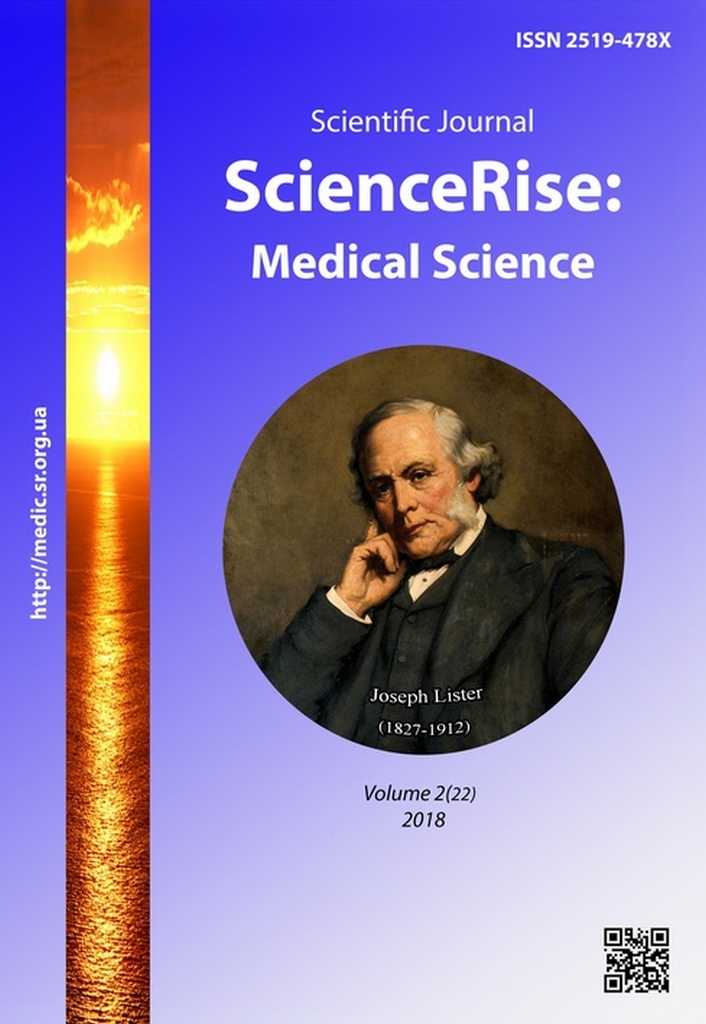Гипонатриемия у пациентов с хронической сердечной недостаточностью и сохраненной фракцией выброса левого желудочка
DOI:
https://doi.org/10.15587/2519-4798.2018.122201Ключові слова:
хроническая сердечная недостаточность, сохраненная фракция выброса, гипонатриемия, клиническое и прогностическое значениеАнотація
Целью исследования было изучить встречаемость гипонатриемии у пациентов с хронической сердечной недостаточностью (ХСН) и СФВЛЖ. Результаты исследования показали, что гипонатриемия чаще ассоциируется с более тяжелым течением заболевания и неблагоприятным исходом у больных с сердечной недостаточностью (СН) и сохраненной фракцией выброса левого желудочка (СФВЛЖ)
Посилання
- McMurray, J. J. J. V. (2015). Improving outcomes in heart failure: a personal perspective. European Heart Journal, 36 (48), 3467–3470. doi: 10.1093/eurheartj/ehv565
- Lorido, J. C. A., Gomez, J. C., Formiga, F., Perez-Barquero, M. M., Vila, J. C. T., Bodas, O. A. et. al. (2013). Hyponatremia as predictor of worse outcome in real world patients admitted with acute heart failure. Cardiology Journal, 20 (5), 506–512. doi: 10.5603/cj.2013.0136
- Braun, M. M., Mahowald, M. (2017). Electrolytes: Sodium Disorders. FP Essent, 459, 11–20.
- Verbalis, J. G., Barsony, J., Sugimura, Y., Tian, Y., Adams, D. J., Carter, E. A., Resnick, H. E. (2009). Hyponatremia-induced osteoporosis. Journal of Bone and Mineral Research, 25 (3), 554–563. doi: 10.1359/jbmr.090827
- Diaconu, C. C., Bartos, D. (2014). Frequency and outcomes of hyponatremic patients with heart failure hospitalized in the Clinical Emergency Hospital of Bucharest. Romanian Journal of Internal Medicine, 52 (1), 24–26.
- Schrier, R. W., Sharma, S., Shchekochikhin, D. (2012). Hyponatraemia: more than just a marker of disease severity? Nature Reviews Nephrology, 9 (1), 37–50. doi: 10.1038/nrneph.2012.246
- Madan, V. D., Novak, E., Rich, M. W. (2011). Impact of Change in Serum Sodium Concentration on Mortality in Patients Hospitalized With Heart Failure and Hyponatremia. Circulation: Heart Failure, 4 (5), 637–643. doi: 10.1161/circheartfailure.111.961011
- Mohammed, A. A., van Kimmenade, R. R. J., Richards, M., Bayes-Genis, A., Pinto, Y., Moore, S. A., Januzzi, J. L. (2010). Hyponatremia, Natriuretic Peptides, and Outcomes in Acutely Decompensated Heart Failure: Results From the International Collaborative of NT-proBNP Study. Circulation: Heart Failure, 3 (3), 354–361. doi: 10.1161/circheartfailure.109.915280
- Aronson, D., Verbalis, J. G., Mueller, M., Krum, H. (2011). Short- and long-term treatment of dilutional hyponatraemia with satavaptan, a selective arginine vasopressin V2-receptor antagonist: the DILIPO study. European Journal of Heart Failure, 13 (3), 327–336. doi: 10.1093/eurjhf/hfq226
- Dimopoulos, K., Diller, G.-P., Petraco, R., Koltsida, E., Giannakoulas, G., Tay, E. L. et. al. (2009). Hyponatraemia: a strong predictor of mortality in adults with congenital heart disease. European Heart Journal, 31 (5), 595–601. doi: 10.1093/eurheartj/ehp495
- Filippatos, G., Khan, S. S., Ambrosy, A. P., Cleland, J. G. F., Collins, S. P., Lam, C. S. P. et. al. (2015). International REgistry to assess medical Practice with lOngitudinal obseRvation for Treatment of Heart Failure (REPORT-HF): rationale for and design of a global registry. European Journal of Heart Failure, 17 (5), 527–533. doi: 10.1002/ejhf.262
- Balling, L., Schou, M., Videbaek, L., Hildebrandt, P., Wiggers, H., Gustafsson, F. (2011). Prevalence and prognostic significance of hyponatraemia in outpatients with chronic heart failure. European Journal of Heart Failure, 13 (9), 968–973. doi: 10.1093/eurjhf/hfr086
- Holland-Bill, L., Christiansen, C. F., Heide-Jorgensen, U., Ulrichsen, S. P., Ring, T., Jorgensen, J. O. L., Sorensen, H. T. (2015). Hyponatremia and mortality risk: a Danish cohort study of 279 508 acutely hospitalized patients. European Journal of Endocrinology, 173 (1), 71–81. doi: 10.1530/eje-15-0111
- Bettari, L., Fiuzat, M., Shaw, L. K., Wojdyla, D. M., Metra, M., Felker, G. M., O’Connor, C. M. (2012). Hyponatremia and Long-Term Outcomes in Chronic Heart Failure – An Observational Study From the Duke Databank for Cardiovascular Diseases. Journal of Cardiac Failure, 18 (1), 74–81. doi: 10.1016/j.cardfail.2011.09.005
- Rusinaru, D., Tribouilloy, C., Berry, C., Richards, A. M., Whalley, G. A. et. al. (2012). Relationship of serum sodium concentration to mortality in a wide spectrum of heart failure patients with preserved and with reduced ejection fraction: an individual patient data meta-analysis. European Journal of Heart Failure, 14 (10), 1139–1146. doi: 10.1093/eurjhf/hfs099
- Kaplon-Cieslicka, A., Ozieranski, K., Balsam, P., Tyminska, A., Peller, M., Galas, M. et. al. (2015). Clinical characteristics and 1-year outcome of hyponatremic patients hospitalized for heart failure. Polish Archives of Internal Medicine, 125 (3), 120–131. doi: 10.20452/pamw.2701
- Barsony, J., Sugimura, Y., Verbalis, J. G. (2010). Osteoclast Response to Low Extracellular Sodium and the Mechanism of Hyponatremia-induced Bone Loss. Journal of Biological Chemistry, 286 (12), 10864–10875. doi: 10.1074/jbc.m110.155002
- Park, S. J., Shin, J. I. (2013). Inflammation and hyponatremia: an underrecognized condition? Korean Journal of Pediatrics, 56 (12), 519–522. doi: 10.3345/kjp.2013.56.12.519
##submission.downloads##
Опубліковано
Як цитувати
Номер
Розділ
Ліцензія
Авторське право (c) 2018 Ekaterina Lazidi, Iurii Rudyk, Iurii Rudyk, Olena Visotska, Olena Visotska, Anna Pecherska, Anna Pecherska

Ця робота ліцензується відповідно до Creative Commons Attribution 4.0 International License.
Наше видання використовує положення про авторські права Creative Commons CC BY для журналів відкритого доступу.
Автори, які публікуються у цьому журналі, погоджуються з наступними умовами:
1. Автори залишають за собою право на авторство своєї роботи та передають журналу право першої публікації цієї роботи на умовах ліцензії Creative Commons CC BY, котра дозволяє іншим особам вільно розповсюджувати опубліковану роботу з обов'язковим посиланням на авторів оригінальної роботи та першу публікацію роботи у цьому журналі.
2. Автори мають право укладати самостійні додаткові угоди щодо неексклюзивного розповсюдження роботи у тому вигляді, в якому вона була опублікована цим журналом (наприклад, розміщувати роботу в електронному сховищі установи або публікувати у складі монографії), за умови збереження посилання на першу публікацію роботи у цьому журналі.










